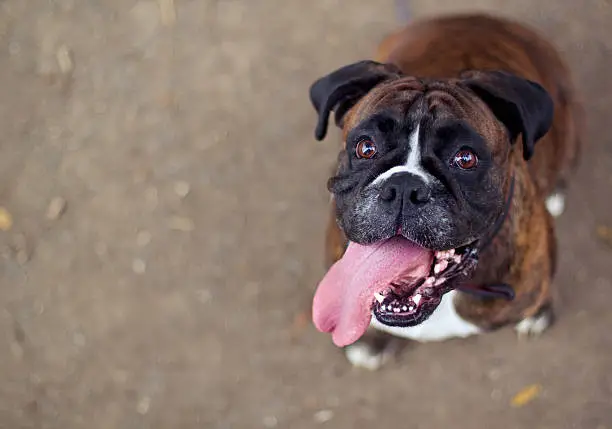Origin and history of the boxer breed from Germany
The German-born Boxer breed is not your typical canine. It personifies a special fusion of power, knowledge, and devotion. You will learn more about this wonderful breed’s illustrious history, which dates back to the late nineteenth century, in this article. In addition, you’ll learn the essential characteristics that attract dog lovers from over the globe to it. The Boxer has an unmatched appeal that has won over families and people looking for a devoted and dependable friend.
Boxer Breed Origins | German History Unveiled
This charm can be seen in its characteristic square-shaped head as well as its beautiful but strong build. You’ll quickly see why the Boxer is the ideal example of a canine “gentle giant,” whether it’s due to their playful demeanor, everlasting devotion, or remarkable trainability. Come along as we elaborate more on this below.
Ever thought where your freckles emerged from, or why you resent cilantro? Discover 35+ of your most intriguing genetic features with AncestryDNA + features and see how your genes may have affected a variety of physical, sensory, physiological, nutritional, and other personal attributes. Simply enroll your DNA kit online and send your saliva specimen to our cutting-edge lab in the pre-paid box. You’ll be able to get your findings online in around six to eight weeks. Buy now.
The origin of the Boxer breed from Germany
The powerful physique, vivacious demeanor, and devoted character of the Boxer breed are well-known traits. This breed’s intriguing history begins in the 19th century and has its roots in Germany. During this period, the Boxer breed started to develop and become more well-known among dog lovers in the nation.
The now-extinct Bullenbeisser breed served as the ancestor of the Boxer breed. A particular breed of hunting dog called a Bullenbeisser was renowned for its powerful build and its capacity to pursue and restrain huge animals, like as bears and boars. These canines were large, robust, and had a strong urge to defend.
German dog lovers saw a fall in the employment of Bullenbeisser as hunting dogs around the end of the 19th century. More effective hunting methods have taken over their functions. In response to this circumstance, dog breeders set out to develop an entirely novel breed that would retain the Bullenbeisser’s attractive characteristics while being used for a different purpose.
Bullenbeissers were mixed with a number of breeds, notably the English bulldog and the English Terrier, to form the Boxer breed. The ultimate result was a breed that was as strong and agile as the Bullenbeisser but also had a more elegant look and a sociable nature that made them good companions.
With the founding of the first Boxer club in Munich in 1895, the effort to advance the Boxer breed gained speed. The Deutscher Boxer-Klub was founded with the intention of advancing and safeguarding the interests and standards of the breed. Breeders began carefully breeding Boxers under the direction of this group with the intention of establishing a dependable and uniform breeding standard.
Recognition of the Boxer breed from Germany
In 1904, the German Kennel Club acknowledged the Boxer breed, and the following year, the American Kennel Club followed suit. This endorsement reaffirmed the Boxer’s status as a highly prized breed among canine aficionados all around the globe.
Georg Alt was one of the key players in the creation of the Boxer breed. German boxer enthusiast Alt was instrumental in enhancing and advancing the breed’s standards. He highlighted the need to improve the Boxer’s disposition and looks while preserving their working prowess.
The evolution of the Boxer breed was significantly influenced by the World Wars. Many Boxers served as security dogs, paramedic dogs, and messenger dogs during World War I. They immediately gained a reputation as trustworthy working dogs because to their fearlessness and devotion in the field.
Unfortunately, because of the lack of resources and the massive damage brought on by the war, the Boxer breed perished during World War II. However, devoted breed aficionados made a concerted effort to conserve the species, and it eventually made a stunning comeback in the years after the war.
Ever thought where your freckles emerged from, or why you resent cilantro? Discover 35+ of your most intriguing genetic features with AncestryDNA + features and see how your genes may have affected a variety of physical, sensory, physiological, nutritional, and other personal attributes. Simply enroll your DNA kit online and send your saliva specimen to our cutting-edge lab in the pre-paid box. You’ll be able to get your findings online in around six to eight weeks. Buy now.
Historical development and popularity of the Boxer breed
The perseverance of dog breeders and fans may be seen in the development of the Boxer variety from the Bullenbeisser to its current form. The Boxer breed’s success and durability have been secured by their efforts to uphold the breed’s criteria and promote its distinctive characteristics, making it a lasting representation of tenacity, devotion, and friendship.
Over time, and with good reason, the Boxer breed has seen steady growth in popularity. These magnificent canines are renowned for their sociable and lively personalities in addition to their powerful and muscular form. The origins of the Boxer breed may be traced to ancient times, when they were developed in Germany as dogs for hunting. They are now among the breeds that people throughout the globe adore and admire.
Reas ons for the popularity of the Boxer breed
Some reasons for the popularity of the Boxer breed include:
1. They make versatile family pets
The adaptability of Boxers as family pets is one factor in their appeal. They are renowned for having a tolerant and kind nature, particularly with kids. Boxers get along well with humans and can develop strong attachments to their owners. They make ideal security dogs since they are fiercely devoted and protective. They make great friends for outdoor activities like running or catch due to their high level of enthusiasm.
2. Eye-catching look
Boxers’ outstanding physical attributes are another factor in why they are so adored. They have a unique and alluring appearance due to their chiseled heads and muscular bodies. They are advantageous for pet owners who like low-maintenance pets since they possess a short coat that needs little upkeep. Boxers have a variety of hues, such as brindle, fawn, and white, which enhances their aesthetic appeal.
3. Knowledge and adaptability
The widespread acceptance of the Boxer breed is also attributed to its intelligence and trainability. They are simple to teach since they are very clever dogs that are eager to please their handlers. Boxers are excellent at learning tricks and orders during obedience training. In addition to making them wonderful companions, this also makes it possible for them to take part in different canine sports and contests.
4. A cheerful and fun-loving disposition
In addition, Boxers are loved by people of all ages because of their energetic and fun-loving personality. They are engaging and fun to be around since they are noted for having puppy-like enthusiasm long into maturity. Boxers are renowned for their silly antics and capacity to make any space more cheerful. They are popular selections for families and people searching for a vivacious and vibrant companion due to their energy and love for life.
Ever thought where your freckles emerged from, or why you resent cilantro? Discover 35+ of your most intriguing genetic features with AncestryDNA + features and see how your genes may have affected a variety of physical, sensory, physiological, nutritional, and other personal attributes. Simply enroll your DNA kit online and send your saliva specimen to our cutting-edge lab in the pre-paid box. You’ll be able to get your findings online in around six to eight weeks. Buy now.
Conclusion
In conclusion, the information provided here on the history and origin of the German boxer breed is pretty fascinating. The widespread acceptance of the Boxer breed is also influenced by its lifespan and health. Boxers may live up to 10 to 12 years if given the right care. They have few breed-specific health concerns and are typically healthy dogs. Nevertheless, like other breeds, they could be predisposed to certain illnesses including hip dysplasia and cardiac issues. Regular vet visits, balanced diets, and physical activity on a regular basis may all assist to improve their general health.
Important Affiliate Disclosure
We at doglinked.com are esteemed to be a major affiliate for some of these products. Therefore, if you click any of these product links to buy a subscription, we earn a commission. However, you do not pay a higher amount for this. Rest easy as the information provided here is accurate and dependable.





